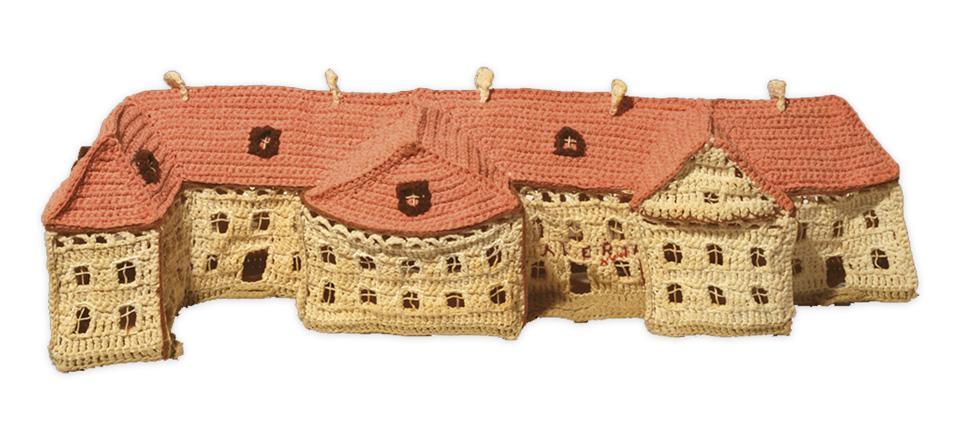Julita Wójcik
The Lace
Julita Wójcik
The Lace, 2005, wool, 20 × 64 × 17 cm
Collection II of the Arsenal Gallery in Białystok. Work purchased by the Podlaskie Association for the Promotion of Fine Arts

Few galleries or museums can pride themselves on having such a non-standard portrait as Galeria Arsenał in Białystok. Only the Museum of the City of Lodz located in the 19th-century Poznański Palace seems to have a similar one. Julita Wójcik’s Lace is a crocheted miniature model of the gallery building. Sturdy walls of the edifice and the institutional gravitas of the gallery have been transformed into ephemeral, soft and somewhat genial walls of woollen yarn.
Wójcik has chosen a non-standard technique for this artistic action. Crocheting, like embroidery or knitting, are handicrafts that once were useful, but now are regarded as more of a hobby, and are stereotypically ascribed to women. They are also associated with folk crafts and amateur creative practices typical of village culture centres. Investigators of women’s history, who conduct their analyses from the feminist position, often emphasise (especially with reference to history) the “subversive” character of handicrafts, interpreting them as one of the few media of creative expression available to women at that time. Interpreting Wójcik’s selection of technique as an attempt to elevate crocheting to the status of art is certainly an overstatement and, in fact, goes somewhat against Wójcik’s general approach. This is because in her works, as she has repeatedly stressed herself, she attempts to de-mythologise the sacred figure of the artist and the elitist status of art. She attempts to reveal the aesthetic element in crocheting, once an everyday activity, and by this to re-value the way of thinking about prosaic, peripheral activities. Above all, she has managed to extract from the stereotypically grey mundaneness something that is pleasing and, in its very usualness, unusual. Yet her actions are seldom completely free from subversiveness, and her seemingly unimportant, always cheerful interventions play with the absurd codes and ingrained schemata of thinking.
The lacy Arsenał is a warm portrait of the gallery, in which it seems unnecessary to seek “politicised” contexts of criticism towards the institution, or perhaps an attempt to curb its mythologised image. The notorious “white cube” loses its power, and the gallery as an institution gains a quotidian, more approachable and less elitist aspect.
Izabela Kopania
translated from Polish by Klaudyna Michałowicz

PLAN YOUR VISIT
Opening times:
Thuesday – Sunday
10:00-18:00
Last admission
to exhibition is at:
17.30